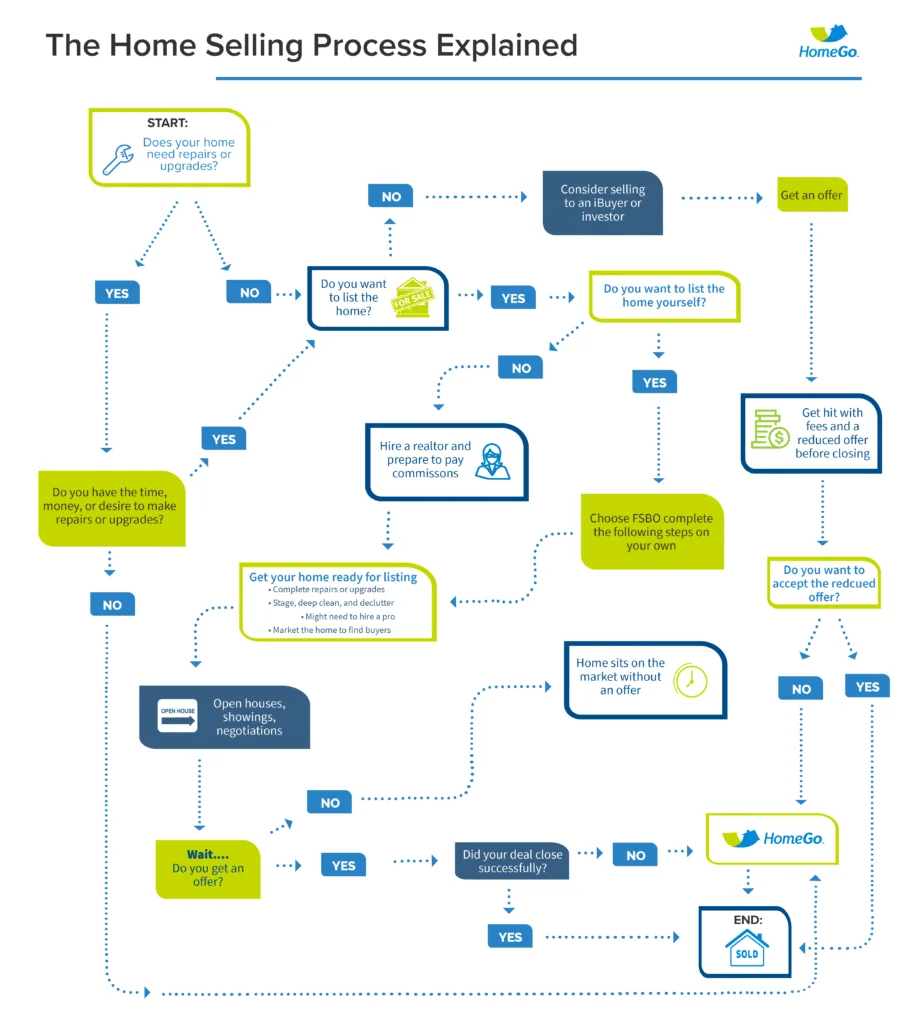Being a first-time home buyer can be stressful, but for many, it’s not until you become a first-time home seller that the real fun begins. The home selling process is filled with ups and downs.
Home Selling Process Flowchart
You need to learn the ins and out to sell your home successfully and there are a lot of routes you could take.
Our home selling process flowchart will guide you through the process from beginning to end.

1. Determine Your Real Estate Selling Strategy
Being a home-seller is like suddenly becoming a small business owner with all of the excitement, hard work, and stress that comes with securing a sale.
No, you don’t have to write out a full business plan. But you do need a selling strategy. Here are some you might choose from.
- Use a real estate agent – It works best for market-ready homes. You will have to pay commission, which the listing agent and buyer’s agent split. These professionals are well worth the money. Many sellers have no idea how much work selling a home is until they try to do it themselves.
- FSBO – For sale by owner works best for market-ready homes. You are responsible for finding potential buyers, handling all of the scheduling, paperwork, and negotiations. FSBOs tend to sell for less and stay on the market longer, according to the National Association of Realtors. The sales price is often a reflection of the fact that prospective buyers knows you’re not paying commissions and wants to share in your savings, or claim all of it for themselves
- Cash Buyer – This works best for homes that need repairs and upgrades. It’s important to realize that people have new home options, and most people want a move-in ready home. Cash buyer strategy makes for a quick, easy home sale, often without a home inspection. You will get less than market value but can save on repairs, commission, extra mortgage payments, and stress, which can make this lowering you asking price and selling for cash a better deal than it appears at face value.
- iBuyer – This is a specific cash buyer that has automated the cash buying process. But it’s important to note that limited types of homes qualify. And it’s best for market-ready homes. iBuyer usually won’t buy homes with disaster damage, foundation issues, mold or asbestos problems, places that aren’t on city water and sewage, mobile homes (which includes those trendy tiny homes). So people who are selling a home that’s over 40 years old are probably out of luck when it comes to iBuyer. The initial offer is also almost always lowered after the in-person inspection.
2. Make Repairs and Upgrades
Making a home market-ready is the most expensive and time-consuming part of the home selling process. Many begin fixing things up before realizing the true cost. Some of the most costly repairs include:
- Electrical work
- Plumbing
- Mold
- Roof
Most buyers will steer clear of “inheriting” your home problems.
3. Stage the Home and Begin Marketing
If you hope to get interested buyers, they need to be able to see themselves in the home. A professional photographer can help you paint this picture.
But you also need to stage the home. This includes typically removing personal items and replacing them with more neutral modern accents.
And you may need to revisit this step and change your strategy if it’s not working. There’s an art and science to staging.

4. Hold Open Houses and Showings
Whether you have a seller’s agent or not, open houses are disruptive and inconvenient, especially if you have pets or kids, both of which should not be home during an open house.
Depending on market conditions, you may be doing one a week or month to generate enough interest.
5. Negotiate Offers
If you’re lucky enough to get to this stage, it’s time to negotiate. This may involve a lawyer or not.
There will undoubtedly be significant legal documents to create, read through, and sign for the sale of your home.
Even if you believe you have a very interested buyer, it’s important to note that the purchase agreement may be contingent on your making more home repairs and spending more money.
At this point, the buyer has the upper hand. They know you’ve invested a lot and are ready to get this deal done.
6. Closing Process
So you’ve made it to the closing table. It’s been a long journey, but it’s all worth it if the deal is finalized. However, the sale can fall through until the closing is final.
A mortgage lender can decide that they don’t want to lend on a home that has work to be done. Or something may come up in the final walkthrough or inspection.
Their current home closing falls through. The buyer could also decide to walk away for a number of reasons. While they’ve signed a contract, the law generally works in their favor.
Even with you have a good real estate agent and aren’t first home buyers or sellers, things can go wrong.
7. The Fastest, Easiest Home Selling Process
Selling a home is a long, expensive process, and a lot can go wrong along the way. Why not skip the process and sell to HomeGo. We buy as-is, no repairs, staging, or upgrades. There are no commissions or fees. Get a same day offer and close in as little as 7 days.
If this home selling process flow chart makes you dizzy, skip the process, and just sell your home. Reach out to get your no-obligation offer.




